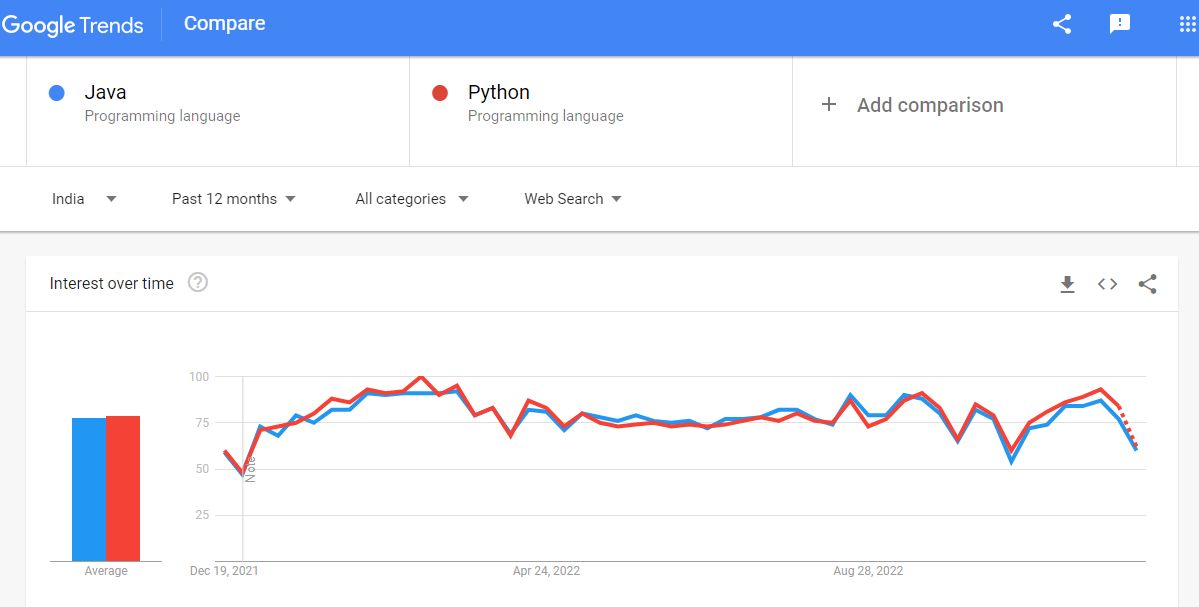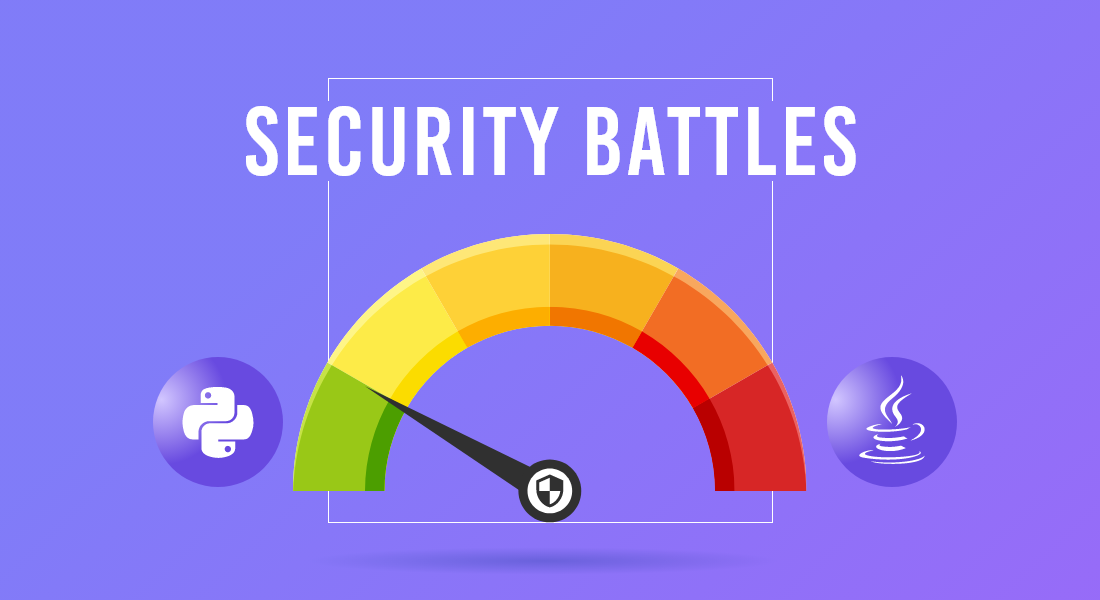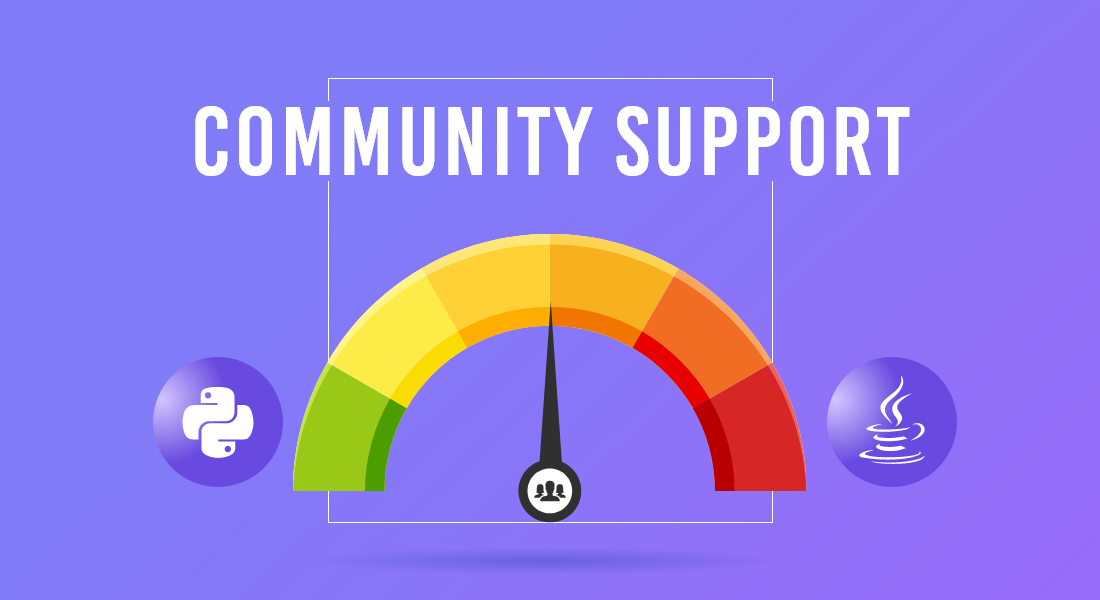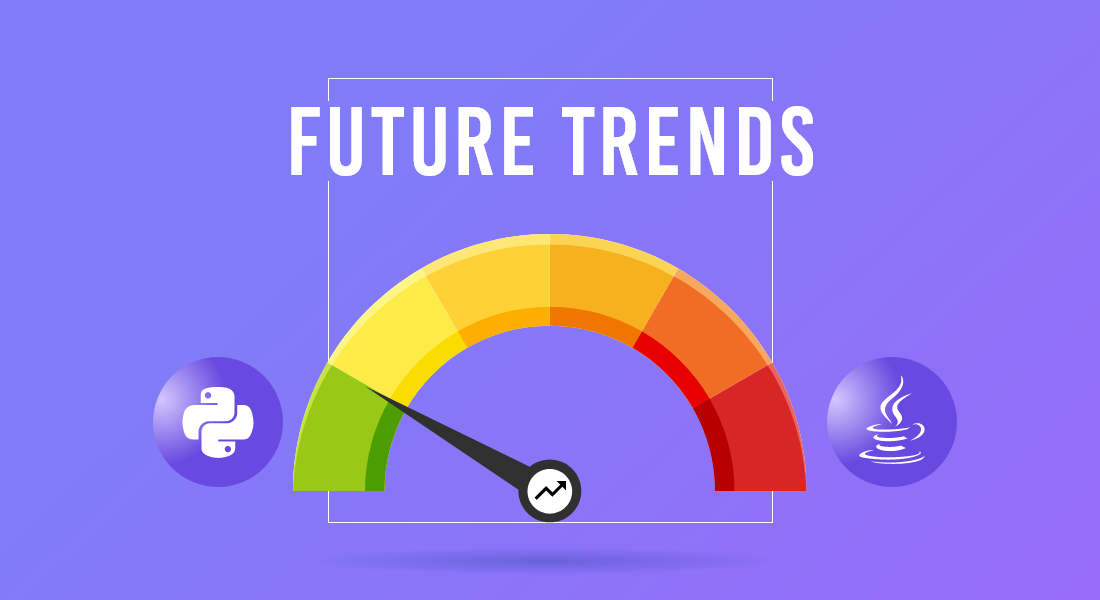| Dimension | Java | Python |
|---|---|---|
| Syntax | Statically typed, requires curly brackets & semicolons, and explicit variable types | Dynamically typed, focus on indentation and whitespace, and implicit variable types |
| Readability & Conciseness | Require explicit code organization due to verbosity | High readability due to clean syntax & uses indentation for code blocks |
| Performance | Agile performance due to bytecode compilation & optimization | Interpretation makes performance slower, but libraries balance the performance |
| Object-Oriented Programming | Strictly adhere to OOP principles | Flexible and open to OOP and paradigms |
| Memory Management | Automatic garbage collection | Java’s memory management + reference counting |
| Application Domain | Android and enterprise-level app development | Web development, scientific computing, data analysis, and scripting |
| Community & Ecosystem | Large & active community + extensive tools and libraries | Active community + rich ecosystem |
| Concurrency & Multithreading | Built-in support | Limited to Global Interpreter Lock |
Quick Summary:
Java and Python are two of the most prominent programming languages in the market. But, with this ever-growing popularity, product owners often get entangled in the never-ending hustle of Java vs Python. In this blog post, we have illustrated a detailed comparison between the two programming languages to get some insight and decide which is ideal for your next project.
Table of Contents
What is Java?
Java is a renowned programming language introduced in 1995. Since its inception, it has become one of the most profound languages in the developer community. It is a general-purpose, compiled language, making it one of the faster options available in the market.
When using Java, the codes written get directly converted to machine code. This provides better and more efficient control over your hardware aspects, like CPU usage. Java is widely used in web development, data-rich applications, or organizations, and it has observed a significant increase in cloud development and IoT. Java is an excellent choice for enterprise-grade web apps, including healthcare, insurance, and government departments.
What is Python?
Python is a renowned general-purpose programming language released originally in 1991. Python allows using it for various applications, like high-level data structures, dynamic binding and typing, and other features that collectively bring forth its effectiveness in building complex applications. The reason behind this factor is that it is essential for scripting, or the ‘glue code’ connects the components. You can also extend for making system calls for all various operating systems and to run a code from c or C++. This dynamic ubiquity and ability to run almost every system architecture are why Python is referred to as a universal language.
Java vs Python Comparison Table
Before letting you know the core differences in depth, let us discuss them briefly so you quickly know which programming language to opt for.
Now that you have a brief idea about both programming languages let’s discuss more differences between Java and Python.
Java vs Python Popularity
Java is one of the most popular and widely used programming languages, such as web development, game development, enterprise software development, android app development, financial app development, and scientific and research application development. Java has built 63,921 websites.
According to the StackOverflow survey of 2022, Java ranks in the 4th position regarding the learning curve and 6th for developers’ choice.
Python is famous for its versatility, flexibility, and easy learning curve. Besides, it is also the first choice for developers to execute machine learning, data science, and scientific computing, scripting & automation tasks. And its large community of developers stands on their toes to resolve any complicated issues without hassle. Python has built 122,232 websites.
The same StackOverflow survey of 2022 ranks Python 3rd for the learning curve and 4th for developers’ choice.
Check out the current Google trend comparing Java vs Python popularity.

No more searching through logs – diagnose and fix errors faster with us!
Hire Java developers that meet your requirements!
Java vs Python Performance
Thanks to statically typed and compiled language, Java turns out to be the fastest than Python. On the other hand, Python performs slower than Java because of its dynamically typed and interpreted language.
The interpreter executes the code line by line, which is time-consuming compared to bytecode execution in Java.
Another reason contributing to slower Python performance is dynamic typing and integrating other language features.
What’s good in Python and Java apps is the execution speed may not even be noticeable for the apps that aren’t computationally intensive.
Moreover, you can boost Python performance by leveraging its libraries or lower-level languages using binding.
Java vs Python Salary
Java developers’ salary ranges from $70,000 to $160,000 per annum. In India, it ranges from 1.8 Lakhs to 9 Lakhs per year.
On the other hand, Python developers also start their salary from $70,000/yearly, and an experience Python developer can even earn $160,000/yearly.
India remains a bit narrower for Python developers because they get less salary than Java developers, which ranges between 3 Lakhs to 7 Lakhs.
Java vs Python Backend
Python is ahead of Java regarding backend development, but Java takes off the limelight in the long run. Besides, it is noteworthy that Java is the first choice for performance-focused websites.
Python’s integration and scripting capabilities are great when the website demands interaction with databases, external functionalities, and APIs. The scripting capabilities ensure automating efficiently, simplifying the backend’s workflows.
Java vs Python Web Development
Java is preferred for enterprise-level web development due to its robust frameworks like JSP, JSF, and Java Serverlets. However, Java requires more verbose code to simplify development than Python. Besides, due to the steep learning curve, newbie developers need help to cope.
Python, on the other hand, rapidly builds the application and delivers quickly. With frameworks like Django and Flask, and extensive support from a large community, Python also contributes to web development. However, Python’s performance will be slower than Java’s and will not prevail like the latter programming language.
Java vs Python Stability
Java obliges to a strict syntax and includes all the variables contrary to Python. Therefore, more code to review, more code volume, and more code to debug or fix. But, as everything is checked at the initial level, the codes written are already optimized, making the application more stable and providing fewer crashes, making Java more suitable for business enterprises.
On the other hand, Python is a good choice for handling enterprise-grade applications and is equal to Java in terms of stability. Many business organizations trust Python within their tech stack.
Java vs Python Architecture Difference
Java entails a runtime environment to initialize and manage the code. This provides a significant architecture experience for product owners. Java converts bytecode into machine language code like 0’s and 1’s and can be easily compiled at the code execution.
However, coming onto Python converts the bytecode into machine code, stores it in another folder, and then transfers it to the Python Virtual Machine, where the code is executed.
Java vs Python Security Battles
Java has been famous for its security measures over the years. Features like runtime access control, memory safety, and bytecode verification make Java a trustworthy programming language. JVM’s security manager enables permission control, restricts certain operations, and implements security policies.
Python, on the other hand, doesn’t have tight security handles like Java. Python has to rely on third-party libraries, which makes it vulnerable to malware attacks. But there is a way to deal with security vulnerabilities: regularly updating Python packages, dependency management, and updating yourself with security vulnerabilities.

Java vs Python Scalability
Java again wins the scalability game against Python. Java leverages hardware resources and multithreading for building large applications. On the other hand, Python’s multithreading is restrictive since it has Global Interpreter Lock. Java even supports executing processes on several threads.
Community Support of Java and Python
The community makes you stronger, and here we are talking about the tech community of your selected programming language, Python vs Java.
A grounded community will stand by you in your difficult times, giving solutions to your problems. Without a doubt, Python and Java have a robust support system that avails several resources. Java is an Oracle product, and hence JavaWorld, JavaRanch, and Oracle Code One have contributed to the broad reach and popularity of the language. Several Java User Groups (JUGs) benefit your developers.
Python user groups are spread across 37 countries and 191 cities, making around 1637 associations. Python programming language is accredited under the groups like PyLadies, PyCon convention, PySlackers, and the FreeNode IRC Python Channel.

Java vs Python Future Trends
Python is the clear winner in all aspects. It has no existing competition in terms of trending technologies. It has one of the easiest architectures, making it perfect for AI (i.e., artificial intelligence.) Python’s easy-to-use interface and architecture give it the upper hand over other languages for designing complex internal logic in machine learning. Writing a program in Java needs more codes, slows development, and hampers focus on the task at hand. However, considering the trends, it looks like Python is the future between Java and Python 2022 comparison.

5 Types of Applications You Can Build With Java
Java is a programming language with which you can build five different types of applications, which are as follows:
Web Application: Java can be leveraged to build and deploy web applications on any server. Also, users can access the web apps through any device.
Desktop Application: Java apps are built to function on various operating systems. Besides, these desktop applications can also be distributed via a range of channels.
Mobile Application: Java is known for building mobile apps on Android and iOS platforms.
Enterprise Application: Businesses rely on Java for building applications. It is a popular choice by entrepreneurs.
Embedded Systems: When building embedded systems built in cars, appliances, and medical devices, Java becomes the first choice for developers.
7 Types of Applications You Can Build With Python
Along with web, desktop, and mobile applications, there are nine other applications that you can build with Python:
Data Science
Python is leveraged for building data science apps. You can leverage libraries like NumPy, Pandas, and SciPy for developing data science apps.
Game Development
PyGame and Panda3D are two game engines popular for supporting Python in game development.
Automation
There are several libraries like BeautifulSoup, Requests, and Selenium that ensure Python executes tasks that can be automated.
Scientific Computing
It involves numerical computing, symbolic mathematics, and bioinformatics research that can execute using Python’s libraries like SymPy, SciPy, and Biopython.
Machine Learning
Python is known for executing Machine Learning tasks easily and swiftly. From building ML models to solving complex problems and implementing neural networks, Python’s libraries like TensorFlow, NumPy, and scikit-learn can process it.
Desktop GUI Application
Executing a graphical user interface is also possible with the help of Python. Frameworks like Tkinton er and PyQT are the backbone of successfully implementing cross-platform desktop apps with GUI.
Internet of Things
Using Python, it is possible to function IoT devices and sensory interactions and build IoT apps. You only need Python developers with hands-on experience in Pygame, Panda3D, and Pyglet.
Want to create your next web app with Python?
Our developers are here to meet your requirements! Contact us and hire Python developer now to build scalable, secure, dynamic enterprise-grade web apps.
Career Opportunities in Python vs Java
There were 8.2M Python developers in demand in 2022, which shows the potential of the programming language. This number is expected to shoot up to 10.2M by 2025. And this growth and popularity are driven by versatility and great command over futuristic possibilities.
Which Are Different Python Jobs?
A Python developer can apply for the below-mentioned roles:
- Software Engineer
- Senior Software Engineer
- DevOps Engineer
- Senior Data Scientist
- Data Scientist
What is the Future Scope of Python?
Python’s dominance as a programming language has been consistent. And since the world is stepping into cognitive technologies, Python will be a great technology to learn and work with.
Python’s scope is endless, from artificial intelligence to big data and data science to machine learning. Top organizations like NASA, Facebook, Google, IBM, and Walt Disney have already leveraged Python and expect to utilize the programming language fully.
On the other hand, if you are a Java developer or aspirant, here is how this programming language will reward you.
There are 400,000+ Java vacancies in the United States. And the number will fill soon with more vacancies opening up again. Java also works across different industries, such as manufacturing, healthcare, gaming, etc.
Which are Different Java Jobs?
Java developers can work for several jobs:
- Jr. programmer
- Senior computer programmer
- Java Developer
- Java architect
- Database administrators
What is the Future Scope of Java?
Just like Python, Java also has much potential to deliver applications. Many large organizations like Amazon, Oracle, Twitter, and Facebook have leveraged Java to scale their business.
Java or Python Which is Better for Future?
In the comparison of which is better Python or Java Python-developed apps, and Java-developed solutions are slow. Python programs run more quickly than Java programs. Because of Python’s incredible run time and speed, web developers find it simpler to create applications and websites using this language. Python is much simpler to understand with its aid, so you can start working on backend programming rather soon. In the long run, however, keep in mind that Java offers higher speeds, which is only significant when running websites with high-performance requirements.
Python and Java are object-oriented programming languages, but Python is preferred for dynamic types, whereas Java uses static types. The most crucial distinction fundamentally impacts how you design, write and troubleshoot programs. Let’s examine two examples of code.
We’ll first create an array in Python, fill it with data, and report it to the console.
Let’s try it in Java next.

public class Test {
public static void main(String args[]) {
String array[] = {Hello, World, Hi there, Everyone, 6};
for (String i : array) {
System.out.println(i);
}
}
}
When To Choose Java?
- Java is highly suitable for developing android or cross-platform applications.
- Java is perfect if you want to develop a middleware application that lies between the OS and other apps running on the OS.
- You can build Enterprise Java applications with a wide range of utilities using the Java programming language.
- I recommend using Java for developing Embedded systems.
- If yours is an extensive corporate system, Java will be ideal for developing your backend solutions.
- Several desktop GUI and gaming apps are built in Java, with beautiful examples depicting the language’s potential.
- Java is best suited for building MVP because of its short development period.
When to Choose Python?
- Select Python when you aspire to develop a new Operating System.
- Python will be your best choice when you want to build a modern AI/ML application.
- I recommend using Python for projects that require image processing and graphic designs. Hence, gaming apps are well-developed in Python.
- Python is an acceptable base language for developing a new programming language.
- Go for Python when you are a fresher in development. It is quick and easy.
- Python is suitable for projects that need DevOps scripting language.
- If you are a data scientist, you will love Python.
- Python is ideal for your project if your app deals with enormous data because it provides the best statistics and analysis tools.
- Choose Python when developing your project idea’s Prototype.
Epilogue
Modern digital businesses need modern and newer tactics to retain their customers. Python is a programming language that is a wholesome framework to accumulate all the much-essential characteristics of a successful current Java vs Python for enterprise applications. If you want to engage your users with data science, machine learning, or artificial intelligence incorporated in your application, We would highly recommend Python developer from a renowned and leading Python app development company, or else if you are looking for extensive application development and want to use Java, then do connect with the best Java development company available.
Frequently Asked Questions (FAQs)
The key difference between both programming languages is that Java is compiled and statically typed language, whereas Python is interpreted and dynamically typed programming language.
Java offers more rapid development than Python as it is highly efficient and works as a compiled programming language. Whereas Python offers straightforward syntax and code, which helps improve the reading of the code base.
Python is widely used in various types of application development. But the main types of web app development that provide an edge to Python over Java are Artificial Intelligence, Data Science, and Machine Learning.
In terms of pace, Java is faster than Python. The reason behind it is the Just-in-Time (JIT) compiler and concurrency support. It is a part of the Java Runtime Environment which improves the performance of Java programs by compiling bytecodes into native machine codes “just in time” to run. The JVM (Java Virtual Machine) directly calls the compiled code. As the code is not interpreted, compiling doesn’t use the processor time and memory; it makes a Java program faster.
In Java, the programs are compiled directly without breaking down the code in binary form, whereas in Python, the programs are interpreted and then assembled the process of recognizing the type of variable which is found during runtime increases the load on the interpreter.
When it comes to comparison between Java and Python, it comes with their set of Pros. and Cons. In the present market scenario, Java is a better choice being faster, more dynamic, and more efficient. But considering the long-term aspect, the future of Python is bright as it is the fastest growing, high-level, and multi-paradigm programming language; the main reason is its ease of learning and working on it.
Python is dynamically scoped, meaning the compiler needs to search for the current block and the calling functions for evaluating an expression. The issue with this approach is that testing in every context makes the process slow and time-consuming.
Database Access Constraints Another reason for Python not being used in production is its database access constraints. While comparing major technologies like JDBC and ODBC, Python’s database access layer is not developed to that extent; this is why Python is rarely used in production, and Java is preferred comparatively.
Your Success Is Guaranteed !
We accelerate the release of digital product and guaranteed their success
We Use Slack, Jira & GitHub for Accurate Deployment and Effective Communication.






